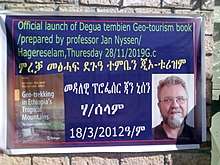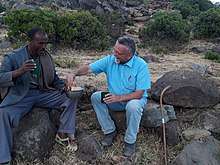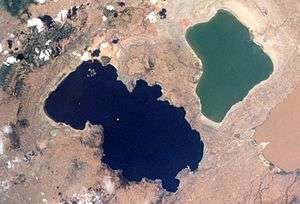Jan Nyssen
Jan Nyssen (born Sint-Martens-Voeren, 1957) is a Belgian physical geographer, and professor of geography at Ghent University.
Jan Nyssen | |
|---|---|
 | |
| Born | August 2, 1957 |
| Nationality | Belgian |
| Alma mater | University of Liège KU Leuven |
| Scientific career | |
| Fields | Geography, Geomorphology |
| Institutions | UGent |
Biography
Nyssen was employed as a mailman (1977-1997) in Liège (Belgium). Starting 1991, he did a parallel study of Geography at the University of Liège; he obtained the degree of Licentiate in Geography in 1995, with a dissertation on soil erosion in Ethiopia.[1] Between 1998 and 2001 he carried out PhD research at KU Leuven University (Belgium), in which he investigated the role of human and natural processes in land degradation in the Ethiopian highlands. Promoters of this research were professors Jean Poesen, Seppe Deckers (both at KU Leuven), Jan Moeyersons (Royal Museum for Central Africa in Tervuren) and Mitiku Haile (Mekelle University in Ethiopia). He worked also several years in projects of university development cooperation in Ethiopia.[2] Since 2007 he is professor at the Department of Geography of Ghent University; in 2014 he was appointed as Full Professor.
Reseach
His research contributes to the identification and quantification of changes in the coupled system “humans-environment” – with focus on slope processes, hydrogeomorphology, land degradation and soil conservation. Most of his research activities are in Ethiopia.
Soil erosion in the Ethiopian highlands
Nyssen’s research showed that high levels of soil loss in the Ethiopian highlands are caused by a combination of erosive rainfall, steep slopes (as a consequence of rapid tectonic uplift during Pliocene and Pleistocene), and impacts of deforestation, overgrazing, an agricultural system where the open-field system dominates, and the aftermath of povery induced by the feudalism. He further studied in the Ethiopian highlands how the high density of soil and water conservation structures led to land resilience.[3] Through the use of rephotography, Prof. Nyssen could link up changes in Ethiopian landscapes with land degradation.[4]
Integration with the local population
In all this, he strongly values indigenous knowledge, as he observed that Ethiopian farmers plough the same lands and hills since thousands of years with their oxen plough. They know their soils and know when rains will come or what they have to plant if rains are late.[5][6][7]
Through the years, he lived the many changes that occurred; since his first stay in 1994, he observed that the amount of food available to rural households, as well as the overall living standard has strongly improved.[3][8]
Lynchets and beaver dams
Nyssen’s research in Belgium is also related to the consequences of human activities on geomorphic processes: the reintroduction of beavers, spoil tips of the derelict coal mining industry, and the age-old agriculture in the Pays de Herve (the region where he was born), which led to the occurrence of lynchets or cultivation terraces, by analogy to a common practice in current Ethiopia;[9] The beaver dams have drawn his attention because they contribute to conserving water in the rivers’ headwaters. He studied their effect on discharges of the Chevral creek, that is part of the Ourthe basin. The research confirmed that such dams have a buffering effect on discharges: downstream the peak discharges are much lower that what was observed before beaver reintroduction.[10]
Teaching
Nyssen lectures Geomorphology, Hydrology, Microclimatology, and Regional Geomorphology for students in Geography and Physical Land Resources at UGent. He promoted dozens of Master and PhD theses, particularly at Ugent (Belgium), KU Leuven (Belgium), Mekelle University (Ethiopia) and Bahir Dar University (Ethiopia).
Functions outside Ghent University
- 2017-2021: President of the Belgian Association of Geomorphologists [11]
- 2019-2020: Editor-in-Chief of professional journal Land Degradation and Development[12]

Publications
Books

Articles in international scientific journals
2020

2019
- Understanding spatial patterns of soils for sustainable agriculture in northern Ethiopia’s tropical mountains[15]
2018
- Persistence and changes in the peripheral Beles basin of Ethiopia[16]
2017
- Boulder-Faced Log Dams as an Alternative for Gabion Check Dams in First-Order Ephemeral Streams with Coarse Bed Load in Ethiopia[17]
- Geographical determinants of inorganic fertiliser sales and of resale prices in north Ethiopia[18]
2016
- Recovery of the aerial photographs of Ethiopia in the 1930s[19]
- Grèzes litées and their genesis: the site of Enscherange in the Rhenish-Ardennes Massif as a case study[20]
2015
- Environmental Conservation for Food Production and Sustainable Livelihood in Tropical Africa[21]
- Land Management in the Northern Ethiopian Highlands: Local and Global Perspectives; Past, Present and Future[3]
2014
- Environmental conditions and human drivers for changes to north Ethiopian mountain landscapes over 145 years[22]
- Twentieth century land resilience in Montenegro and consequent hydrological response[23]
- Lynchets in eastern Belgium — a geomorphic feature resulting from non-mechanised crop farming[9]
2012
- Belgium's burning coal tips – coupling thermographic ASTER imagery with topography to map debris slide susceptibility[24]
2011
- The use of the marasha ard plough for conservation agriculture in Northern Ethiopia[25]
- Effect of beaver dams on the hydrology of small mountain streams: Example from the Chevral in the Ourthe Orientale basin, Ardennes, Belgium[10]
2010
- Digital Photographic Archives for Environmental and Historical Studies: An Example from Ethiopia[26]
- Slope aspect affects geomorphic dynamics of coal mining spoil heaps in Belgium[27]
- Impact of soil and water conservation measures on catchment hydrological response—a case in north Ethiopia[28]
2009
- Desertification? Northern Ethiopia re-photographed after 140 years[29]
- Transhumance in the Tigray Highlands (Ethiopia) [30]
- How soil conservation affects the catchment sediment budget – a comprehensive study in the north Ethiopian highlands[31]
- Effects of land use and land cover on sheet and rill erosion rates in the Tigray highlands, Ethiopia[32]
- An upland farming system under transformation: Proximate causes of land use change in Bela-Welleh catchment (Wag, Northern Ethiopian Highlands)[33]
- Land degradation and soil and water conservation in tropical highlands[34]
2008
- Spatial and temporal variation of soil organic carbon stocks in a lake retreat area of the Ethiopian Rift Valley[35]

- Effects of region-wide soil and water conservation in semi-arid areas: the case of northern Ethiopia[36]
- Environmental change, geomorphic processes and land degradation in tropical highlands[37]
- Dynamics of soil erosion rates and controlling factors in the Northern Ethiopian Highlands – towards a sediment budget[38]
- Soils and land use in the Tigray highlands (Northern Ethiopia)[6]
2007
- Interdisciplinary on-site evaluation of stone bunds to control soil erosion on cropland in Northern Ethiopia[39]
2006
- Processes and rates of rock fragment displacement on cliffs and scree slopes in an amba landscape, Ethiopia[40]
- Comment on “Modelling the effect of soil and water conservation practices in Tigray, Ethiopia” [41]
- Assessment of gully erosion rates through interviews and measurements: a case study from northern Ethiopia[42]
2005
2004
- Human impact on the environment in the Ethiopian and Eritrean highlands—a state of the art[44]
- Environmental policy in Ethiopia: a rejoinder to Keeley and Scoones[45]
- The effectiveness of loose rock check dams for gully control in Tigray, northern Ethiopia[46]
2002
- Spatial distribution of rock fragments in cultivated soils in northern Ethiopia as affected by lateral and vertical displacement processes[47]
- Impact of road building on gully erosion risk: a case study from the Northern Ethiopian Highlands[48]
- The environmental significance of the remobilisation of ancient mass movements in the Atbara–Tekeze headwaters, Northern Ethiopia[49]
2001
- Removal of rock fragments and its effect on soil loss and crop yield, Tigray, Ethiopia[50]
2000
- Soil and water conservation in Tigray (Northern Ethiopia): the traditional daget technique and its integration with introduced techniques[51]
- Vertic movements and the developments of stone covers and gullies, Tigray Highlands, Ethiopia[52]
- Tillage erosion on slopes with soil conservation structures in the Ethiopian highlands[53]
Others
Nyssen also contributed to many other publications as co-author – see UGent’s academic bibliography[54]
Involvement for and with society
Nyssen’s interest in Geography "was mainly motivated by the willingness to contribute to solving issues of unequal development worldwide”.[55] His current research is related to land degradation and land rehabilitation. For instance, in Ethiopia he monitored how large tracts of land could be restored thanks to the conservation activities of millions of farmers. With colleagues, he also supports reforestation projects, leading to a yearly 10,000 tonnes of additional carbon storage.[55]
Starting point are the consequences of climate change for the inhabitants of developing countries, such as Ethiopia: increases in rainfall are linked to climate change. Yet, as rain is highly seasonal (most of the rains fall within two months time), additional rain in the rainy season also leads to floodings and catastrophes.[56]
Nyssen also stresses the social context of global warming, inasmuch as authorities stimulate unnecessary energy consumption such as tax-free company cars or non-taxation of kerosene; they also make airport expansion plans.[55] He stated that:
Finally, one gets the feeling that ‘Big Oil’ lobby is so strong, can we have an impact at all? (…) Society should switch from fossil-fuel based growth to socially-adapted green shrinking, which is possible if the economy does not need to sustain corporate greed. [55]
Also in Ethiopia, he continues to support the population of the villages where he stays several weeks a year,[57] among others through projects for water and ecological sanitation as well as carbon sequestration in soils. This resulted also in a book in the local Tigrinya language.[7]
Links with climate change and the situation in his home country are common; Nyssen stressed in 2019 in a video message in the framework of the “We Change for Life” campaign, that the inhabitants of 9 small villages in their projects in Ethiopia could annually sequester about half the carbon volume [58] as compared to what the whole Flemish region in Belgium could reach as reduction of carbon emissions (that was a meagre 2.5% of the objectives).[59]
Nyssen is also involved in favour of public footpaths in the area of Vottem, Herstal and Liège in Belgium.[60]
References
- Foreword I of “Geotrekking in Ethiopia’s Tropical Mountains” (Mitiku Haile) https://rd.springer.com/content/pdf/bfm%3A978-3-030-04955-3%2F1.pdf
- Foreword II (Hans Hurni) “Geotrekking in Ethiopia’s Tropical Mountains” https://rd.springer.com/content/pdf/bfm%3A978-3-030-04955-3%2F1.pdf
- Land Management in the Northern Ethiopian Highlands: Local and Global Perspectives; Past, Present and Future
- Humans Greening a Landscape https://science.sciencemag.org/content/341/6145/485
- Ethiopië boert goed, maar kiest helaas opnieuw voor extensieve landbouw https://www.mo.be/analyse/helaas-kiest-men-opnieuw-voor-extensieve-landbouw-in-ethiopie
- Soils and land use in the Tigray highlands (Northern Ethiopia)
- ካብ ሓረስቶት ደጉዓ ተምቤን እንታይ ንስምዕ? What do we hear from the farmers in Dogu'a Tembien? [in Tigrinya] https://www.researchgate.net/publication/309669762_What_do_we_hear_from_the_farmers_in_Dogu%27a_Tembien_in_Tigrigna
- In 1984 stierven in Ethiopië 400.000 mensen. Dreigt er nu een herhaling? https://www.rd.nl/vandaag/buitenland/in-1984-stierven-in-ethiopi%C3%AB-400-000-mensen-dreigt-er-nu-een-herhaling-1.521004
- Lynchets in eastern Belgium — a geomorphic feature resulting from non-mechanised crop farming
- Effect of beaver dams on the hydrology of small mountain streams: Example from the Chevral in the Ourthe Orientale basin, Ardennes, Belgium
- Activity report of the Belgian Association of Geomorphologists(2017-2018)
- https://onlinelibrary.wiley.com/page/journal/1099145x/homepage/editorialboard.html?=#SectionEditors
- Geo-trekking in Ethiopia’s Tropical Mountains https://www.springer.com/gp/book/9783030049546
- The Zeyi Cave Geosite in Northern Ethiopia
- Nyssen, Jan; Tielens, Sander; Gebreyohannes, Tesfamichael; Araya, Tigist; Teka, Kassa; Van De Wauw, Johan; Degeyndt, Karen; Descheemaeker, Katrien; Amare, Kassa; Haile, Mitiku; Zenebe, Amanuel; Munro, Neil; Walraevens, Kristine; Gebrehiwot, Kindeya; Poesen, Jean; Frankl, Amaury; Tsegay, Alemtsehay; Deckers, Jozef (2019). "Understanding spatial patterns of soils for sustainable agriculture in northern Ethiopia's tropical mountains". PLOS ONE. 14 (10): e0224041. doi:10.1371/journal.pone.0224041. PMC 6804989. PMID 31639144.
- Persistence and changes in the peripheral Beles basin of Ethiopia
- Boulder-Faced Log Dams as an Alternative for Gabion Check Dams in First-Order Ephemeral Streams with Coarse Bed Load in Ethiopia
- Geographical determinants of inorganic fertiliser sales and of resale prices in north Ethiopia
- Recovery of the aerial photographs of Ethiopia in the 1930s
- Grèzes litées and their genesis: the site of Enscherange in the Rhenish-Ardennes Massif as a case study
- Environmental Conservation for Food Production and Sustainable Livelihood in Tropical Africa
- Environmental conditions and human drivers for changes to north Ethiopian mountain landscapes over 145 years
- Twentieth century land resilience in Montenegro and consequent hydrological response
- Belgium's burning coal tips – coupling thermographic ASTER imagery with topography to map debris slide susceptibility
- The use of the marasha ard plough for conservation agriculture in Northern Ethiopia
- Digital Photographic Archives for Environmental and Historical Studies: An Example from Ethiopia
- Slope aspect affects geomorphic dynamics of coal mining spoil heaps in Belgium
- Impact of soil and water conservation measures on catchment hydrological response—a case in north Ethiopia
- Desertification? Northern Ethiopia re-photographed after 140 years
- Nyssen, Jan; Descheemaeker, Katrien; Zenebe, Amanuel; Poesen, Jean; Deckers, Jozef; Haile, Mitiku (2009). "Transhumance in the Tigray highlands (Ethiopia)". Mountain Research and Development. 29 (3): 255–264. doi:10.1659/mrd.00033.
- How soil conservation affects the catchment sediment budget – a comprehensive study in the north Ethiopian highlands
- Effects of land use and land cover on sheet and rill erosion rates in the Tigray highlands, Ethiopia
- An upland farming system under transformation: Proximate causes of land use change in Bela-Welleh catchment (Wag, Northern Ethiopian Highlands)
- Land degradation and soil and water conservation in tropical highlands
- Spatial and temporal variation of soil organic carbon stocks in a lake retreat area of the Ethiopian Rift Valley
- Effects of region-wide soil and water conservation in semi-arid areas: the case of northern Ethiopia
- Environmental change, geomorphic processes and land degradation in tropical highlands
- Dynamics of soil erosion rates and controlling factors in the Northern Ethiopian Highlands – towards a sediment budget
- Nyssen, Jan; Poesen, Jean; Gebremichael, Desta; Vancampenhout, Karen; d'Aes, Margo; Yihdego, Gebremedhin; Govers, Gerard; Leirs, Herwig; Moeyersons, Jan; Naudts, Jozef; Haregeweyn, Nigussie; Haile, Mitiku; Deckers, Jozef (2007). "Interdisciplinary on-site evaluation of stone bunds to control soil erosion on cropland in Northern Ethiopia". Soil and Tillage Research. 94 (1): 151–163. doi:10.1016/j.still.2006.07.011. hdl:1854/LU-378900.
- Processes and rates of rock fragment displacement on cliffs and scree slopes in an amba landscape, Ethiopia
- Comment on “Modelling the effect of soil and water conservation practices in Tigray, Ethiopia” Agric. Ecosyst. Environ. 105 (2005) 29–40
- Assessment of gully erosion rates through interviews and measurements: a case study from northern Ethiopia
- Rainfall erosivity and variability in the Northern Ethiopian Highlands
- Nyssen, Jan; Poesen, Jean; Moeyersons, Jan; Deckers, Jozef; Haile, Mitiku; Lang, Andreas (2004). "Human impact on the environment in the Ethiopian and Eritrean highlands - a state of the art". Earth-Science Reviews. 64 (3–4): 273–320. doi:10.1016/S0012-8252(03)00078-3.
- Environmental policy in Ethiopia: a rejoinder to Keeley and Scoones
- Nyssen, J.; Veyret-Picot, M.; Poesen, J.; Moeyersons, J.; Haile, Mitiku; Deckers, J.; Govers, G. (2004). "The effectiveness of loose rock check dams for gully control in Tigray, Northern Ethiopia". Soil Use and Management. 20: 55–64. doi:10.1111/j.1475-2743.2004.tb00337.x.
- Spatial distribution of rock fragments in cultivated soils in northern Ethiopia as affected by lateral and vertical displacement processes
- Impact of road building on gully erosion risk: a case study from the Northern Ethiopian Highlands
- The environmental significance of the remobilisation of ancient mass movements in the Atbara–Tekeze headwaters, Northern Ethiopia
- Removal of rock fragments and its effect on soil loss and crop yield, Tigray, Ethiopia
- Soil and water conservation in Tigray (Northern Ethiopia): the traditional daget technique and its integration with introduced techniques
- Vertic movements and the developments of stone covers and gullies, Tigray Highlands, Ethiopia
- Tillage erosion on slopes with soil conservation structures in the Ethiopian highlands
- https://biblio.ugent.be/person/802000198480
- Testimony for #WeChangeForLife https://wechangeforlife.org/2019/04/24/jan-nyssen-full-professor/
- “Vergroening in de Sahel is onbetwist” https://radio1.be/afrikaanse-klimaatvluchtelingen-zullen-massaal-komen-maar-klopt-dat-wel
- Bezoekje van de proffen https://laurensinethiopia.wordpress.com/2016/08/23/bezoekje-van-de-proffen/
- Videoboodschap in het kader van de campagne #WeChangeForLife https://www.youtube.com/watch?v=lKxy1eN5uKE&feature=youtu.be
- Voortgangsrapport 2016-2017, Vlaams Klimaatbeleidsplan 2013-2020 (Tabel 3-1) https://www.lne.be/sites/default/files/atoms/files/VORA2016-2017_Mitigatie.pdf
- François Fornieri, the Liège boss of Mithra, appropriates public trails! (26/6/2020) https://world-today-news.com/francois-fornieri-the-liege-boss-of-mithra-appropriates-public-trails/
External links
| Media offices | ||
|---|---|---|
| Preceded by Chris Barrow |
Editor-in-Chief of Land Degradation & Development 2019–2020 |
Succeeded by Vanessa Wong |

.jpg)